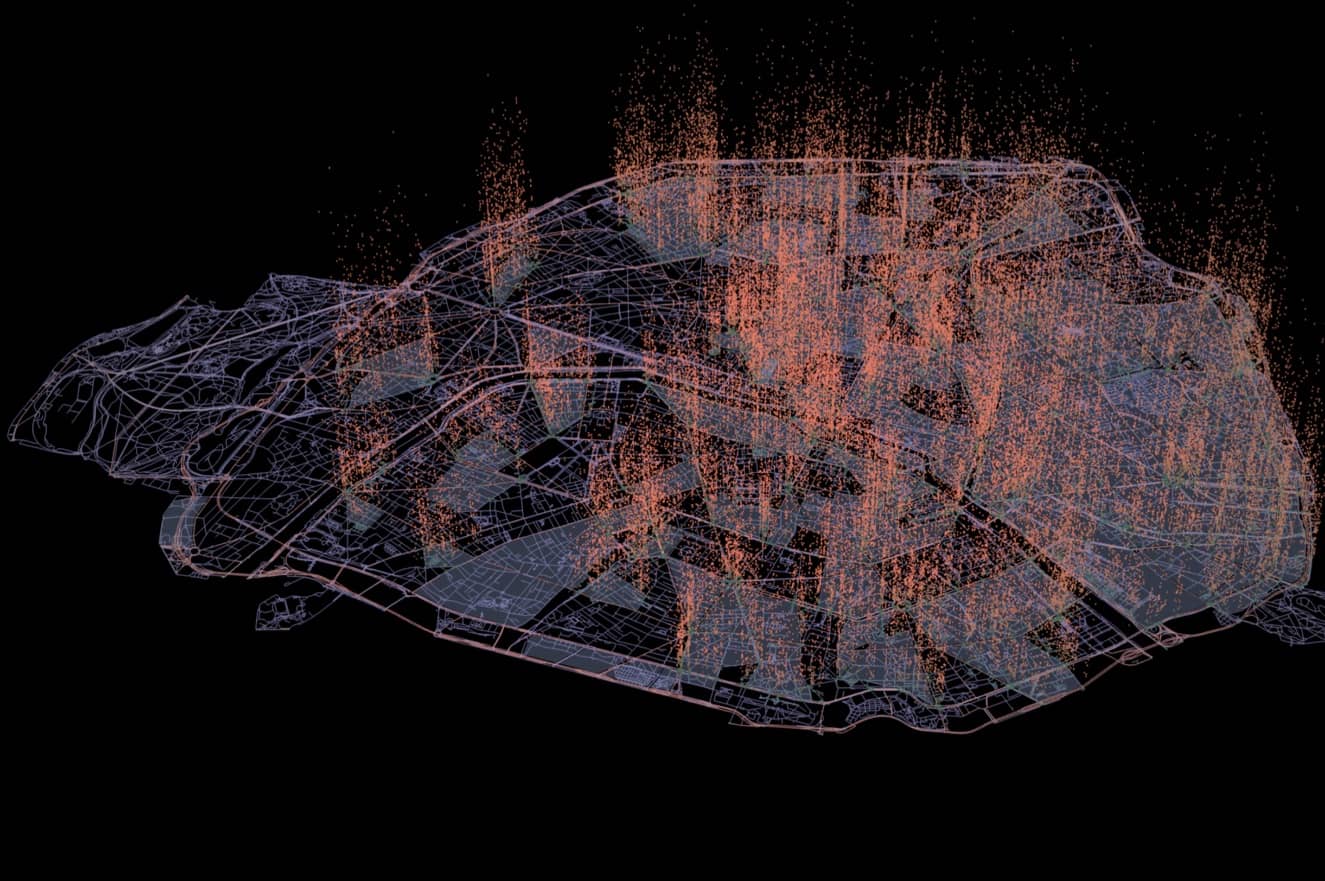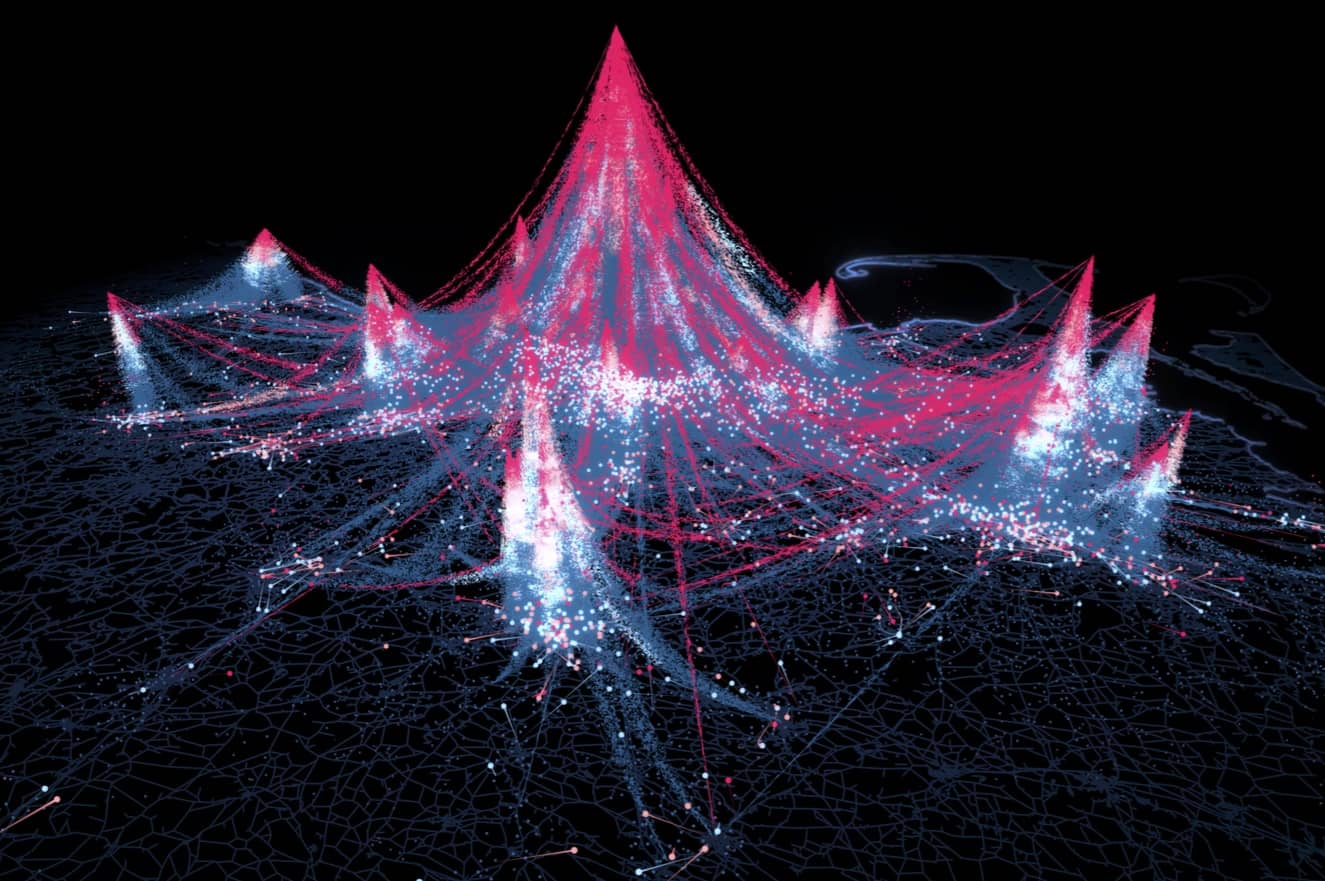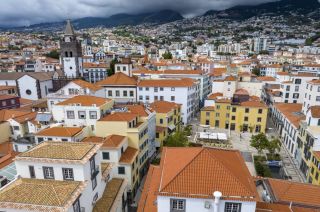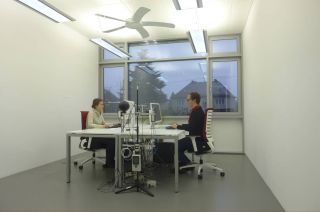
www.buildingsandcities.org/insights/research-pathways/human-centric-city.html
Creating a Human-centric City with Digital Tools

RESEARCH PATHWAY: personal reflections on a career in research
Carlo Ratti (Massachusetts Institute of Technology - MIT) reflects on the work of the Senseable City Lab. Its pioneering research in understanding how people actually use cities and how urban environments could respond dynamically can enhance capacity and the lived experiences.
In the discipline of urbanism, where futurists and dreamers have long held disproportionate sway, the fast-growing suite of new technologies fueled collective reveries of a new urban future: the 'smart city'. Social scientists have long been vexed by a messy human world that fails to resemble their elegant models; perhaps the rise of ubiquitous computing could finally close the gap between the two. Big Data held the promise of providing 'perfect' information, and the Internet of Things might give our cities perfect efficiency. Should achieving a city with the precision of clockwork be our goal? Is optimization the purpose of human life? Couldn't this dream easily become a nightmare一of surveillance, control, and a boot on humanity's face? As Rich Gold (1995) asked: 'how smart does your bed have to be before you are afraid to go to sleep at night?'.
My research career began just before the 'smart cities' took off. I had started my education as a civil engineer. My PhD research was at the intersection of architecture and computer science - and sought out ways to bring the two together. In 2000 I started working as a postdoc with Hiroshi Ishii at the MIT Media Lab. His Tangible Media Group was exploring the convergence of bits and atoms in our everyday life. That endeavor excited me, but I wanted to move to a different scale一from objects to buildings, and perhaps even to cities themselves.
In 2004, together with Assaf Biderman, I founded the Senseable City Lab (SCL) at MIT. Our argument for the group was embedded in the choice of 'senseable' rather than 'smart' for its name. We wanted to study how we could use urban-scale digital networks not to optimize cities, but to create urban environments that listened to people and ultimately became as dynamic as they are. For 10,000 years cities have thrived on a touch of chaos; their capacity for serendipity and collective participation is the source of their vitality. As the great Jane Jacobs (1961, p. 238) argued, 'cities have the capability of providing something for everybody, only because, and only when, they are created by everybody'.
Could new technologies enhance that capacity rather than stifle it? We thought so. These were the days of the early Internet, when we (somewhat naively) imagined a future of individual empowerment and bottom-up collaboration like never before. We believed that the democratic spirit of Jacobs could be a perfect match for the open-source ethic of Firefox and Wikipedia, and we sought out to bring them together. Rather than aspiring to optimize the city, our research was devoted to using technology to create a human-centric city: a 'Senseable City'. In the past 20 years, our research has helped change the conversation about the future of cities by putting people at the center of our practice. The pathway we have taken since has followed that question to its natural conclusion, making the most of new technologies to answer it and aiming ever closer to its human core.
From the outset, we committed to interdisciplinarity. The SCL itself was one of the first, lab-sized bridges between technology and urbanism, allowing us to ferry an incredible array of knowledge from one field to the other, and we embedded our commitment to making connections between different fields within our team. I was an engineer, architect and computer scientist, and my founding partner Assaf Biderman was a physicist. Our disciplinary diversity has since extended across hundreds of lab members, and with the addition of two more principal investigators: Fábio Duarte and Paolo Santi, an urban planner and a computer scientist respectively. A page on our website maps the web of connections between our researchers that makes our work possible.
In addition to this diversity, we are also proud to have a heterogeneity of procedural workflows in the proposal and execution of our projects themselves. We do not receive any funding from MIT; every project arrives through a different pipeline. We collaborate with a variety of research institutions, corporate, municipal, and national partners. This leads to a many different fields of inquiry. The funding model tilts our work toward the applied and the practical - what can help citizens in the near term.
Several of the Senseable City Lab's early successes came from our attention to a new data source that brought us closer to people than ever before: cell phones. Long before cell phones were the omni-capable supercomputers that they are today, we were among the first to realize that their baseline capabilities一to follow people's location and their communication一could allow us to understand city-level human behavior like never before. In our Real-Time Rome project undertaken in 2006, we demonstrated how cell phone data could allow us to map the pulse of the Italian capital in real-time: to monitor congestion, locate every bus and train, and follow its entire population as they burst into the streets in the moments after Italy won the 2006 World Cup. It was especially that final example, using technologies to reveal the scale of a great city's euphoria, that captured imaginations and inspired future research. For example, New York Talk Exchange undertaken in 2007 tracked how telecommunications linked every neighborhood of New York City was connected to different cities across the planet. We were mapping something that had never existed before: an international, digital layer of New York that could only be understood by overlaying data onto the city's physical space. We also wanted to share results publicly一at the Venice Biennale and The Museum of Modern Art in New York respectively一to start a conversation about privacy and other potential risks related to the use of digital devices in our everyday life.
We realized that digital sensing could allow us to understand cities in radically new ways. In a 2009 project, Trash Track, we attached small sensors to pieces of garbage and showed how they traveled across the country to reach their final points of disposal. Simply finding new moving objects upon which to affix these sensors remains one of our most dependable sources of groundbreaking insights (Boustani et al. 2011). In Urban Sensing (O'Keeffe et al. 2019), we found that by equipping only a few dozen taxicabs with sensors, we could collect data on a huge amount of a city over the course of a day. In Good Vibrations, we discovered that the built-in accelerometers of our phones traveling across bridges allowed for cheap, shockingly accurate monitoring to their structural integrity (Matarrazzo et al. 2022). By detecting the smallest changes of how bridges vibrate, we can provide early warning signs for damage and could theoretically extend their lives by decades. In Bike Trafficking, we revealed the hidden movements of the stolen bikes of Amsterdam; some followed similar patterns, a mobility 'subnetwork' that may reveal the workings of an organized crime ring (Venverloo et al. 2023).
The availability of Big Data - which has grown exponentially since we started - has allowed us to validate old theoretical hypotheses with unprecedented precision and test new ones that could never have been investigated before. Twenty years ago, as a student, I realized that the path I followed from my bedroom to my department was, in fact, two different paths - a different set of turns for each direction. I was consistently inconsistent, a small but frustrating realization for a student devoting his life to rational thinking. If not taking the most efficient path, what was I doing? In 2021, we finally had the technology to figure it out. Following cell phone data for hundreds of thousands of walkers, we observed that human beings do not automatically take the shortest path but the 'pointiest path' - pointing directly toward the destination as much as possible, even if traveling at small angles would be more efficient (Bongiorno et al. 2021). Our technology may be rational, but human behavior is not.

Another universal law of human movement was identified in Wanderlust: people's frequency of visitation to a given site is inversely proportional to the square of its distance from their homes (Schläpfer et al. 2021). This data, we believe, provides a quantified corollary to the idea of a '15-minute city' and could guide us toward the future of more walkable neighborhoods. We also have made great strides by using Big Data speculatively-combining information about the world we know with hypotheticals about the world we could someday have. By analyzing travel patterns for taxis, we were able to estimate how many cars could come off the road in possible future scenarios of car-sharing and ride-sharing technologies (Vazifeh et al. 2018). This showed that a huge amount of congestion and carbon emissions could be eliminated.
From the very beginning, I have always enjoyed being involved in the minutia of research, Yet, as the team has grown, I have had to somewhat distance myself, and play a more reactive role, providing feedback to researchers rather than driving their decisions. I have also had to devote more of my time to other responsibilities, such as business development and contact with people in government and industry. I keep the lab attuned with new trends, help develop new research questions, seek out partners, and ensure that we are always working at the cutting edge. After all, the socio-technical circumstances upon which the SCL was founded are over 20 years old - if we are to maintain our hold on the protean zeitgeist, we need to be constantly reinventing ourselves.
Going forward, SCL is focusing on how to solve the pressing issues. In early 2020, an ongoing study of MIT's email networks accidentally became a natural experiment to measure one of the most profound manipulated variables of our time: the onset of the COVID pandemic. We discovered how the lockdown and the transition of the university community to an online environment weakened its social fabric: people strengthened their "strong ties" to close contacts but lost the vital network of 'weak ties' to casual acquaintances which allow new ideas to spread. This has implications beyond the COVID-19 lockdown: it shows how the Internet affects human socialization writ large (Carmody et al. 2022). We have also been bringing data to the forefront of tackling the climate crisis. Our 2016 Treepedia project mapped urban greenery in neighborhoods across the planet using Google Street View imagery. Not only does this project highlight areas where governments should double down on urban greening, it empowers residents to quantify the disparities they experience every day and advocate for more investment. In 2023, we released Flatburn: a low-cost, open-source, 3D-printed environmental scanner that will allow cities around the world to assess environmental quality. These high-resolution, real-time tools will allow people and cities to keep up with the climate crisis, which is moving far too quickly for traditional data methods to keep up (Wang et al. 2023).
Ultimately, our research practice has kept asking questions that are relevant to citizens. How can we understand how people, technology, and cities mix? How can we tell a story about this complicated interface that people will understand? How can our digital tools inform not only top-down management, but bottom-up action? Our commitment to open-sourcing lies at the heart of these concerns. We want to equip everyone to better understand their city-and even 'hack' it, as Sassen (2019) would say. Sensing started out as a question of how the city could sense people, but we believe that even greater potential lies in creating tools that will allow people to sense the city and one another.
References
Bongiorno, Christian, Yulun Zhou, Marta Kryven, David Theurel, Alessandro Rizzo, Paolo Santi, Joshua Tenenbaum, and Carlo Ratti. (2021). Vector-based pedestrian navigation in cities. Nature Computational Science, 1(10), (October): 678-85. https://doi.org/10.1038/s43588-021-00130-y.
Boustani, A., Lewis Girod, Dietmar Offenhuber, R. Britter, M. Wolf, David Lee, Stephen Miles, Assaf Biderman, and C. Ratti. (2011). investigation of the waste-removal chain through pervasive computing. IBM Journal of Research and Development, 55 (April 1): 11:1-11. https://doi.org/10.1147/JRD.2010.2089564.
Carmody, Daniel, Martina Mazzarello, Paolo Santi, Trevor Harris, Sune Lehmann, Timur Abbiasov, Robin Dunbar, and Carlo Ratti. (2022). The Effect of Co-Location on Human Communication Networks. Nature Computational Science 2(8) (August): 494-503. https://doi.org/10.1038/s43588-022-00296-z.
Gold, Rich. (1995). How smart does your bed have to be, before you are afraid to go to sleep at night? Cybernetics and Systems, 26(4) (July 1): 379-86. https://doi.org/10.1080/01969729508927503.
Jacobs, Jane. (1961). The Death and Life of Great American Cities. Random House.
Matarazzo, Thomas J., Dániel Kondor, Sebastiano Milardo, Soheil S. Eshkevari, Paolo Santi, Shamim N. Pakzad, Markus J. Buehler, and Carlo Ratti. (2022). Crowdsourcing bridge dynamic monitoring with smartphone vehicle trips. Communications Engineering 1(1) (November 3): 1-13. https://doi.org/10.1038/s44172-022-00025-4.
O'Keeffe, Kevin P., Amin Anjomshoaa, Steven H. Strogatz, Paolo Santi, and Carlo Ratti. (2019). Quantifying the sensing power of vehicle fleets. Proceedings of the National Academy of Sciences, 116(26) (June 25): 12752-57. https://doi.org/10.1073/pnas.1821667116.
Sassen, Saskia. (2019). Cities help us hack formal power systems. CARGC Papers. 12. https://repository.upenn.edu/cargc_papers/12
Schläpfer, Markus, Lei Dong, Kevin O'Keeffe, Paolo Santi, Michael Szell, Hadrien Salat, Samuel Anklesaria, Mohammad Vazifeh, Carlo Ratti, and Geoffrey B. West. (2021). The universal visitation law of human mobility. Nature, 593(7860) (May): 522-27. https://doi.org/10.1038/s41586-021-03480-9.
Vazifeh, M. M., P. Santi, G. Resta, S. H. Strogatz, and C. Ratti. (2018). Addressing the minimum fleet problem in on-demand urban mobility. Nature, 557( 7706) (May): 534-38. https://doi.org/10.1038/s41586-018-0095-1.
Venverloo, Titus, Fábio Duarte, Tom Benson, Pietro Leoni, Serge Hoogendoorn, and Carlo Ratti. (2023). Tracking stolen bikes in Amsterdam. PLOS ONE, 18(2) (February 15): e0279906. https://doi.org/10.1371/journal.pone.0279906.
Wang, An, Yuki Machida, Priyanka deSouza, Simone Mora, Tiffany Duhl, Neelakshi Hudda, John L. Durant, Fábio Duarte, and Carlo Ratti. (2023). Leveraging machine learning algorithms to advance low-cost air sensor calibration in stationary and mobile settings. Atmospheric Environment, 301 (May 15): 119692. https://doi.org/10.1016/j.atmosenv.2023.119692.
Latest Peer-Reviewed Journal Content
Living labs: epistemic modelling, temporariness and land value
J Clossick, T Khonsari & U Steven
Co-creating interventions to prevent mosquito-borne disease transmission in hospitals
O Sloan Wood, E Lupenza, D M Agnello, J B Knudsen, M Msellem, K L Schiøler & F Saleh
Circularity at the neighbourhood scale: co-creative living lab lessons
J Honsa, A Versele, T Van de Kerckhove & C Piccardo
Positive energy districts and energy communities: how living labs create value
E Malakhatka, O Shafqat, A Sandoff & L Thuvander
Built environment governance and professionalism: the end of laissez-faire (again)
S Foxell
Co-creating justice in housing energy transitions through energy living labs
D Ricci, C Leiwakabessy, S van Wieringen, P de Koning & T Konstantinou
HVAC characterisation of existing Canadian buildings for decarbonisation retrofit identification
J Adebisi & J J McArthur
Simulation and the building performance gap [editorial]
M Donn
Developing criteria for effective building-sector commitments in nationally determined contributions
P Graham, K McFarlane & M Taheri
Reimagining circularity: actions for optimising the use of existing buildings
R Lundgren, R Kyrö, S Toivonen & L Tähtinen
Effective interdisciplinary stakeholder engagement in net zero building design
S Vakeva-Baird, F Tahmasebi, JJ Williams & D Mumovic
Metrics for building component disassembly potential: a practical framework
H Järvelä, A Lehto, T Pirilä & M Kuittinen
The unfitness of dwellings: why spatial and conceptual boundaries matter
E Nisonen, D Milián Bernal & S Pelsmakers
Environmental variables and air quality: implications for planning and public health
H Itzhak-Ben-Shalom, T Saroglou, V Multanen, A Vanunu, A Karnieli, D Katoshevski, N Davidovitch & I A Meir
Exploring diverse drivers behind hybrid heating solutions
S Kilpeläinen, S Pelsmakers, R Castaño-Rosa & M-S Miettinen
Urban rooms and the expanded ecology of urban living labs
E Akbil & C Butterworth
Living with extreme heat: perceptions and experiences
L King & C Demski
A systemic decision-making model for energy retrofits
C Schünemann, M Dshemuchadse & S Scherbaum
Modelling site-specific outdoor temperature for buildings in urban environments
K Cebrat, J Narożny, M Baborska-Narożny & M Smektała
Understanding shading through home-use experience, measurement and modelling
M Baborska-Narożny, K Bandurski, & M Grudzińska
Building performance simulation for sensemaking in architectural pedagogy
M Bohm
Beyond the building: governance challenges in social housing retrofit
H Charles
Heat stress in social housing districts: tree cover–built form interaction
C Lopez-Ordoñez, E Garcia-Nevado, H Coch & M Morganti
An observational analysis of shade-related pedestrian activity
M Levenson, D Pearlmutter & O Aleksandrowicz
Learning to sail a building: a people-first approach to retrofit
B Bordass, R Pender, K Steele & A Graham
Market transformations: gas conversion as a blueprint for net zero retrofit
A Gillich
Resistance against zero-emission neighbourhood infrastructuring: key lessons from Norway
T Berker & R Woods
Megatrends and weak signals shaping future real estate
S Toivonen
A strategic niche management framework to scale deep energy retrofits
T H King & M Jemtrud
Generative AI: reconfiguring supervision and doctoral research
P Boyd & D Harding
Exploring interactions between shading and view using visual difference prediction
S Wasilewski & M Andersen
How urban green infrastructure contributes to carbon neutrality [briefing note]
R Hautamäki, L Kulmala, M Ariluoma & L Järvi
Implementing and operating net zero buildings in South Africa
R Terblanche, C May & J Steward
Quantifying inter-dwelling air exchanges during fan pressurisation tests
D Glew, F Thomas, D Miles-Shenton & J Parker
Western Asian and Northern African residential building stocks: archetype analysis
S Akin, A Eghbali, C Nwagwu & E Hertwich



Latest Commentaries
Building-Related Research: New Context, New Challenges
Raymond J. Cole (University of British Columbia) reflects on the key challenges raised in the 34 commissioned essays for Buildings & Cities 5th anniversary. Not only are key research issues identified, but the consequences of changing contexts for conducting research and tailoring its influence on society are highlighted as key areas of action.
Lessons from Disaster Recovery: Build Better Before
Mary C. Comerio (University of California, Berkeley) explains why disaster recovery must begin well before a disaster occurs. The goal is to reduce the potential for damage beforehand by making housing delivery (e.g. capabilities and the physical, technical and institutional infrastructures) both more resilient and more capable of building back after disasters.